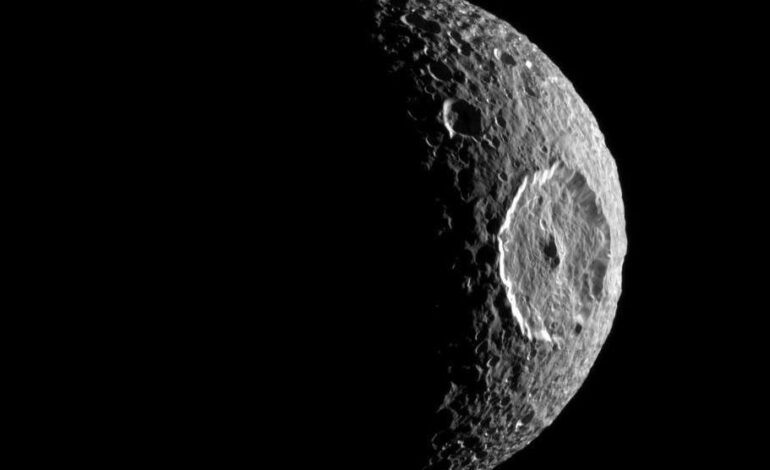Scientists Uncover Evidence of Ocean Beneath Saturn’s Moon Mimas

Research indicates that Saturn’s moon Mimas may harbor a hidden ocean beneath its icy crust. This revelation stems from studies mapping the thickness of Mimas’ ice, suggesting that the moon could possess an ocean formed relatively recently in its geological history. The findings could pave the way for future missions aimed at detecting this potential ocean.
At a recent conference, Alyssa Rhoden, a planetary scientist at the Southwest Research Institute (SwRI) in Boulder, Colorado, shared insights about Mimas during the joint Europlanet Science Congress and Division for Planetary Sciences meeting. Unlike other icy moons in the Saturnian and Jovian systems, such as Enceladus and Europa, which exhibit surface features indicative of subsurface oceans, Mimas appears largely unchanged. Its surface lacks the cracks and crevasses typically associated with fluctuating ice volumes, leading to questions about its geological activity.
According to earlier data from NASA’s Cassini spacecraft, there is growing support for the idea of a relatively young ocean beneath Mimas’ surface. Initial skepticism surrounding these claims has diminished as more detailed observations have emerged. Current estimates suggest that this ocean lies beneath 12 to 19 miles (20 to 30 kilometers) of solid ice, making it a prime candidate for future exploration.
Rhoden and her team utilized models derived from Europa’s heat flow patterns to assess Mimas’ ice shell thickness and thermal dynamics. Their findings indicate that once melting begins on the moon, it progresses rapidly. The melting is closely tied to Mimas’ orbital dynamics, which have likely changed over millions of years.
The gravitational interaction between Mimas and Saturn influences the moon’s shape and thermal state. Scientists suggest that a shift to a more eccentric orbit has created the heat necessary for melting ice into water. As Mimas’ orbit continues to evolve, the tidal forces exerted by Saturn could lead to further melting, potentially creating a new ocean.
Research shows that this orbital change likely occurred within the last 10 to 15 million years, a relatively brief period in astronomical terms. This timeframe aligns with estimates of the age of the hypothesized ocean, suggesting that it may not be a remnant of Mimas’ initial formation but rather a more recent geological development.
Future Exploration of Mimas
The potential for a subsurface ocean has implications for future missions to Mimas. Rhoden’s simulations indicate that while detecting the ocean may be complex, it remains a feasible objective for an orbiter. The team is optimistic that measuring the heat flow from Mimas could reveal the presence of liquid water beneath the ice.
Mimas is often colloquially referred to as the “Death Star moon,” due to its resemblance to the fictional space station in the Star Wars franchise. The moon’s largest crater, Herschel crater, spans 80 miles (130 kilometers) and is crucial for understanding the moon’s geological history. The characteristics of this crater provide insights into the moon’s internal structure and the conditions during its formation.
Research indicates that Herschel crater likely formed during a period when Mimas was on the verge of melting, suggesting that the moon’s ice was not entirely rigid. Adeene Denton, another planetary scientist at SwRI, has stated that Mimas must have been near a critical melting point for the crater to form as observed. This study, recently published in the journal Earth and Planetary Science Letters, extends the timeframe for Herschel’s formation from one million years to an estimated ten million years, providing a clearer picture of Mimas’ geological evolution.
The ongoing investigation into Mimas illustrates a growing consensus among scientists about its potential as a young ocean world. As research continues, the narrative surrounding this enigmatic moon is becoming increasingly coherent, suggesting that Mimas may play a significant role in our understanding of ocean worlds beyond Earth.






